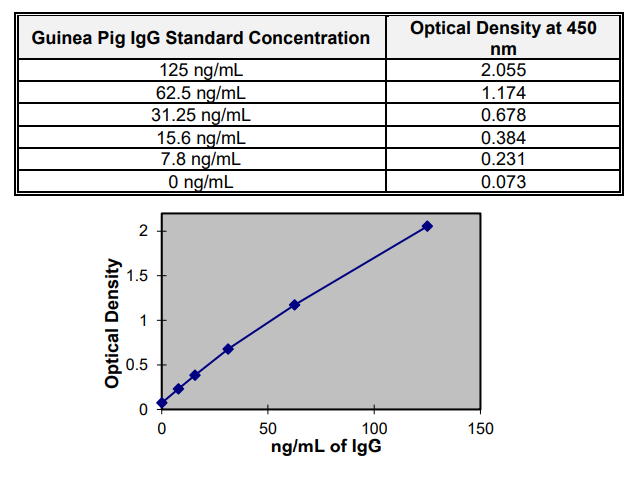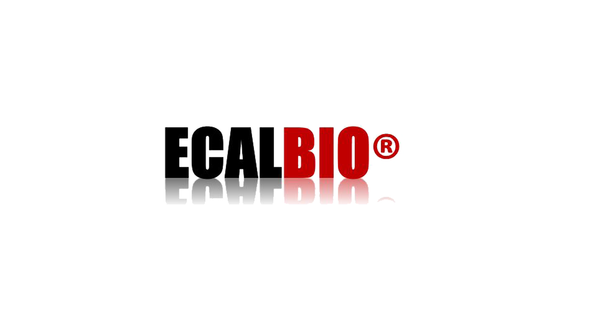Description
The IMMUNO-TEK Guinea Pig IgG ELISA Kit is a rapid, easy to use enzyme-linked immunosorbent assay (ELISA) designed for the measurement of guinea pig IgG in plasma, serum, or other guinea pig biological fluids.
The IMMUNO-TEK Guinea Pig IgG ELISA Kit is for Research Purposes Only.
Zeptometrix | 0801029 | Guinea Pig IgG ELISA Datasheet
PRINCIPLE OF THE TEST
Microplate wells coated with polyclonal antibodies to guinea pig IgG form the capture phase of the assay. Guinea pig IgG specimen samples along with the supplied standard are diluted appropriately with Assay Diluent and are then incubated in the microplate wells. After a wash step, captured guinea pig IgG in the well is incubated with detector antibody, a polyclonal anti-guinea pig IgG conjugated to horseradish peroxidase (HRP). This antibody reacts only to the Fc portion of the immunoglobulin molecule allowing for the specific detection of IgG. After another wash step, the chromogenic substrate tetramethyl benzidine (TMB) is added and a blue color develops in proportion to the amount of guinea pig IgG that has been bound to the antibody-coated plate. The enzyme reaction is stopped by the addition of Stop Solution which results in a color change to yellow which can be measured spectrophotometrically at 450 nm. The concentrations of guinea pig IgG are then calculated from a standard curve.
REAGENTS
Materials Supplied:
• Microplate, (1x96 well): 12x 8-well strips coated with goat anti-guinea pig IgG
• Guinea Pig IgG Detector Antibody (12 ml): Contains HRP conjugated goat anti-guinea pig IgG
• Guinea Pig IgG Standard (7 ml): Contains 125 ng/ml of guinea pig IgG in Assay Diluent
• Assay Diluent (100 ml): Contains PBS, blocking proteins, Triton X-100® and 2-chloroacetamide as a preservative.
• 10X Plate Wash Buffer (125 ml): Contains PBS, Tween 20® and 2-chloroacetamide as a preservative
• Substrate (12 ml): Contains Tetramethyl Benzidine (TMB)
• Stop Solution (12 ml): Proprietary formulation
• Microplate Sealers (1 pk): 10 sealers per pack
• Sealable Plastic Bag (1 bag): For storage of unused microplate strips
® Triton X-100 is a registered trademark of The Dow Chemical Company.
Tween 20 is a registered trademark of Croda International PLC.
Materials required but not supplied:
• Personal protection equipment (Disposable gloves, lab coat, safety glasses, etc.)
• Distilled or deionized water
• Graduated cylinders and beakers
• Test tubes and racks for preparing specimen and IgG standard dilutions
• Validated adjustable micropipettes and tips, single and/or multi-channel
• Timer
• Validated incubator or temperature controlled room at 18-25˚C
• Absorbent paper towels
• Validated microplate reader capable of measuring optical density at 450nm
• Automatic microplate washer or manual vacuum aspiration equipment
• Graph paper or computer graphing software
STORAGE
Store all kit reagents at 2-8°C. Do not freeze. Unused microplate strips should be kept in a sealed bag with desiccant to minimize exposure to moisture. All reagents stored and handled properly are stable at least until the expiration date printed on the kit box label.
PRECAUTIONS
• Prior to performing the assay, carefully read all instructions.
• Use universal precautions when handling kit components and test specimens.**
• To avoid cross-contamination, use separate pipette tips for each specimen.
• When testing potentially infectious specimens, adhere to all applicable local, state and federal regulations regarding the disposal of biohazardous materials.
• Stop Solution contains hydrochloric acid, which may cause severe burns. In case of contact with eyes or skin, rinse immediately with water and seek medical assistance. Wear protective clothing and eyewear.
**MMWR, June 24, 1988, Vol. 37, No. 24, pp. 377-382, 387-388 PREPARATION OF REAGENTS
Plate Wash Buffer:
Dilute 10X Plate Wash Buffer 1:10 in distilled or deionized water prior to use. Mix thoroughly. Prepared 1X Plate Wash Buffer can be stored at 2-8C for up to one week. Additional 10X Plate Wash Buffer (ZMC Catalog #: 0801060) may be ordered if needed.
Guinea Pig IgG Standard Curve
The Guinea Pig IgG Standard is provided at 125 ng/mL and should be diluted in Assay Diluent to prepare a standard curve as shown in the table below.

Specimen Dilutions:
Guinea pig sera or plasma have a range of 5-10 mg/mL of IgG. Because of this, we recommend preparing a 1:200,000- 250,000-fold dilution in Assay Diluent for initial testing. To reduce dilution error, three dilution steps are recommended. For example, three 1:60-fold serial dilutions, where 15uL is added to 885uL of Assay Diluent, is a convenient dilution scheme.
Other specimen samples may contain more or less IgG and will need to be diluted appropriately. A 3-fold dilution is usually sufficient to avoid possible matrix interference.
TEST PROCEDURE
Allow all reagents to reach room temperature before use. Prepare reagents as described above. Label test tubes to be used for the preparation of standards and specimen samples. If the entire microplate will not be used for testing, remove surplus strips from the plate frame and place into the sealable plastic bag with desiccant. Seal bag and store at 2-8°C.
Step 1: Label each strip on its end tab to ensure identity should the strips become detached from the plate frame during the assay.
Step 2: Pipette 200 uL of standards 1-6 into duplicate wells.
Step 3: Pipette 200 uL of each specimen sample into duplicate wells.
Step 4: Cover the microplate with a plate sealer and incubate for 30 minutes at room temperature (18-25˚C).
Step 5: Aspirate the contents of each well and wash 4 times with 1X Plate Wash Buffer (See Preparation of Reagents section). To wash, fill the wells with at least 300 uL of 1X plate wash buffer and aspirate. Perform 4 fill/aspirate cycles. After the final wash cycle, thoroughly blot the plate by carefully striking on a pad of absorbent paper towels. Continue striking until no visible droplets of Plate Wash Buffer are observed.
Step 6: Pipette 100 uL of Guinea Pig IgG Detector Antibody into each well.
Step 7: Cover the plate with a plate sealer and incubate for 30 minutes at room temperature (18-25˚C).
Step 8: Wash the plate 4 times with 1X Plate Wash Buffer as described in Step 5.
Step 9: Pipette 100 uL of Substrate into each well.
Step 10:Incubate the plate for 30 minutes at room temperature (18-25˚C) without a plate cover. A blue color will develop in wells containing guinea pig IgG.
Step 11:Pipette 100 uL of Stop Solution into each well. A color change from blue to yellow will occur. Gently tap microplate to mix.
Step 12:Within 15 minutes, read the optical density of each well at 450 nm using a microplate reader.
EXPECTED RESULTS
Below is an example of a standard curve and should not be used to calculate actual samples. Variations may be observed from laboratory to laboratory due to pipetting, incubator temperatures, plate readers, etc.

CALCULATION OF RESULTS
Test Validity:
• The mean optical density of the 0 ng/mL standard must be below 0.200.
• The mean optical density of the 125 ng/mL must be above 1.000.
• It is recommended that specimen samples be re-assayed with a greater or lesser dilution when the mean optical density value does not fall within the standard curve.
Calculation:
1. Calculate the mean optical density (OD) values for each set of standards and diluted specimen samples.
2. Using linear graph paper or graphing software, plot the mean OD values of each standard on the Y-axis versus the corresponding concentration of standards on the X-axis.
3. Draw the best fit curve through these points to construct a standard curve. A point-to-point construction will be the
most accurate.
4. Determine the IgG concentration of each diluted specimen sample by interpolation from the standard curve.
5. Multiply by the dilution factor used to dilute each specimen sample to determine the IgG concentration of the original specimen sample.
PERFORMANCE CHARACTERISTICS
Specificity:
The Guinea Pig IgG detector antibody in this kit has been shown by immunoelectrophoresis and/or ELISA to react only with the Fc portion of the guinea pig IgG heavy chain but not with the Fab portion of guinea pig immunoglobulins. No reaction to other immunoglobulin classes (IgA, IgM, etc.) or other non-immunoglobulin serum proteins were detected.
Hamster IgG may cross-react with this ELISA test. Serum from Human, Sheep, Rabbit, Chicken, Donkey, Goat, Bovine, Mouse and Rat showed no reaction.
Precision:

PROCEDURAL FLOW CHART
PREPARE REAGENT DILUTIONS
=>
PIPETTE SPECIMENS AND STANDARDS
=>
INCUBATE 30 MINUTES AT ROOM TEMPERATURE
=>
WASH PLATE
=>
PIPETTE DETECTOR ANTIBODY
=>
INCUBATE 30 MINUTES AT ROOM TEMPERATURE
=>
WASH PLATE
=>
PIPETTE SUBSTRATE
=>
INCUBATE 30 MINUTES AT ROOM TEMPERATURE
ADD STOP SOLUTION AND READ AT 450 NM
3 Reviews
-
Sorprendente
La consegna più veloce e i prezzi equi dei prodotti mi hanno stupito così tanto che ora sono pienamente soddisfatto della qualità e del servizio del Gentaur
-
Excelente
La respuesta de la empresa, el envío y el embalaje fueron excelentes y realmente recomiendo sus productos a otros. Gracias por una experiencia tan maravillosa.
-
Speedy delivery
as compare to other they deliver in time. I was not expecting such speedy delivery I was shocked when I got my parcel on time






